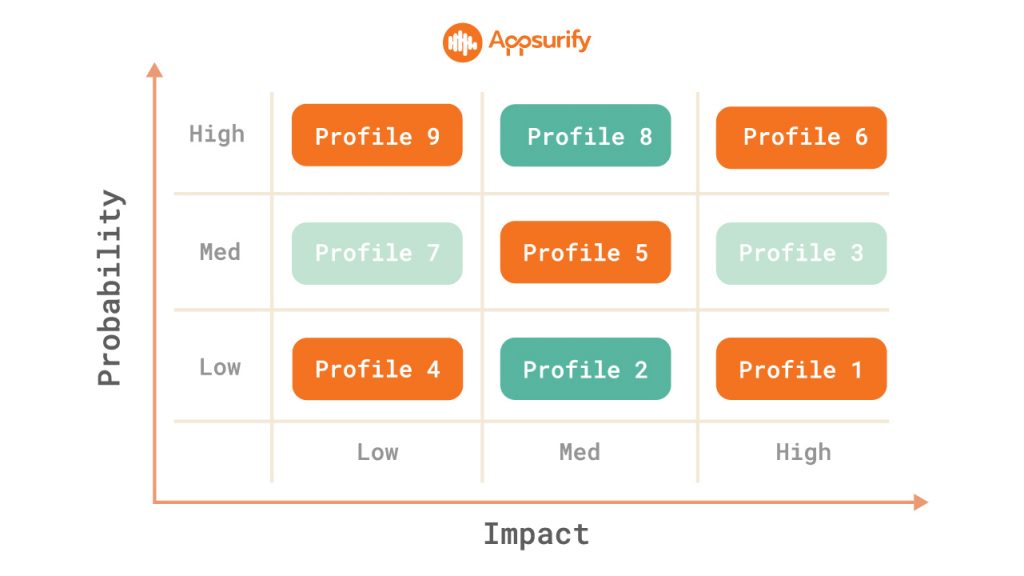Whether operating an online store, dealing with cloud computing deployment, or handling mission-critical information like online banking, all projects will take on some degree of product risk. Depending on the severity of these risks, inadequate testing during software development could result in disappointed customers, angry clients, a hindered company reputation, legal fees, or even project failure.
Risk based testing is one way to inspect, analyze, and prioritize software functionality risks, thereby creating a better user experience. In this article, we’ll take a closer look at what risk based testing is, the advantages of risk based testing, when to employ it, the testing process, and getting started.
What Is Risk Based Testing?
Risk based testing (RBT) is the process of testing software on the basis of risk impact and probability.
By assessing risks based on factors like product complexity, the criticality of software modules, components most likely to malfunction, number of impacted users, or financial risks, risk based testing can help your team efficiently deliver quality products.
One of the great things about this testing strategy is its collaborative nature—it allows for open communication amongst QA teams, developers, managers, clients, and other stakeholders. Defining and setting parameters for risk requires input from developers as well as stakeholders, this way internal and external teams can go through the process of product testing in a highly visible and strategic way.
Also, testers can use this strategy to target changes after developer commits and save time by risk testing only the areas of the application that have changed.
What Are the Advantages of Risk Based Testing?
Some of the benefits of risk based testing include:
Better quality
The focus on high-risk probability allows developers to dedicate time to the most important product functions first. The result is a product that is much less likely to present critical defects. It’s quality assurance at its finest.
Optimized testing
By evaluating risks, development teams are given a structured plan of action on how best to proceed. This creates a built-in project organization so testing is more productive.
User-focused
The features and functions that are most likely to impact customers are thoroughly tested, so your team can deliver a valuable product—with confidence.
When Is Risk based Testing Appropriate?
Any team looking for a high-quality QA experience should consider risk based testing. However, there are certain factors that make this testing strategy especially important.
For example, if your team is involved in inherently risky projects such as digital financing or online health insurance processing, risk based testing is a must. Projects dealing with sensitive, mission-critical software should be rigorously risk-tested for functionality.
Agile testing often requires teams to meet rigid sprint deadlines. If your team finds itself having to cut down test coverage to meet these deadlines, risk based testing can help. By focusing software testing only on the risk associated with recent developer changes, testing can be expedited, and teams can meet their deadlines without sacrificing quality.
Risk based testing can also be used to help speed up the shift-left testing process if development takes longer than expected.
By optimizing the testing process, teams can avoid costly development bottlenecking. And because risk based testing provides a clear structure for developers to follow, milestones can be efficiently reached and easily communicated to stakeholders.
How to Implement Risk based Testing
Risk based testing can take many forms and be as basic or as comprehensive as you wish. These general steps will give you an overview of the testing process:
Indentify risk
Project developers, testers, and other stakeholders come together to identify internal and external risk factors that may impact either developers or customers negatively. Working with experienced software architects during this stage is beneficial.
Analyze and prioritize
To analyze each risk, developers identify risk impact and probability. Impact parameters for a software module are defined by:
- Frequency of usage
- Priority
- Cost of fixing
Probability parameters are defined by:
- Complexity
- Reliability on other modules
- Application technology
- Experience of developers with the technology
Impact and probability are expressed on a risk assessment matrix, such as the one shown below, and modules are ranked as high, medium, or low risk.

Execute tests
Based on your matrix, create a detailed testing strategy designed to address areas of most concern. Test high-risk modules early, leaving low-risk modules for the end of development.
Track, monitor, and reassess risks
Watch identified risks throughout development. Ask your team: did tests fail? Were bugs found? Are there any new risks?
Experience the Advantages of Risk Risk Based Testing with TestBrain
TestBrain is a risk based testing tool that uses machine learning to determine the areas of an application that have changed after each developer commit and only runs the relevant tests impacted by those changes.
Gain a visual representation of your application at a moment in time to help pinpoint the introduction of new defects while also being alerted of risky code changes, resulting in instant feedback and over 90 percent time reduction in executing tests.
Contact us to start testing smarter, not harder, and benefit from the advantages of risk based testing.
